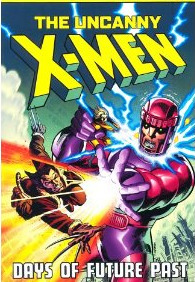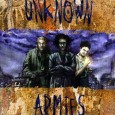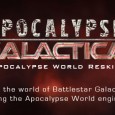 GM: Carl Rigney
GM: Carl Rigney
Players: Sean Nittner, Karen Twelves, Eric K Lytle
System: Psi*Run
Setting: Days of Future Past (X-men)
This is what I know. Psi*Run is a game about amnesiac psychics on the run. This is what we played: amnesiac mutants on the run. Yep, I’m down with this hack.
The hack is based on the 1980s X-men storyline of the same name. From Wikipedia:
“Days of Future Past” is a popular storyline in the Marvel Comics comic book The Uncanny X-Men issues #141 and #142, published in 1981. It deals with a dystopian alternative future in which mutants are incarcerated in internment camps. An older Kitty Pryde transfers her mind into the younger, present-day Kitty Pryde, who brings the X-Men to prevent a fatal moment in history which triggers anti-mutant hysteria.
We were each given a Mutant ID sheet (character sheet) and filled in these questions:
I don’t know who I am! But when I look in the mirror, I see: An “M” is carved into my face and…
What powers do you want? Be vague. Keep a very loose idea of who you are. It make change. Other players may get to help define who you are.
So we started answering those questions. I went for a young black man with electrokenisis. I wanted lightning powers and the ability to “talk” to machines via electricity. Karen was a young woman who had been badly beaten up (still covered in bruises) and could steal powers. Eric had crazy 80’s x-men green hair and the power to duplicate himself.
This power became incredibly… complicated. More on that later.
Carl explained some of the game, the dice and scene mechanics an we stated playing. The first thing I noticed was that to do something we were rolling dice, rolling dice created all kinds of narrative outcomes (being caught, getting hurt, powers going wild), which led to situations that we needed to do something, which meant rolling dice.
We did a lot of narrating coolness, and a lot of dice rolling, but not much player interaction or role-playing. Part of this was due to the frantic chase mechanics in the game. Unless the highest dice are allocated avoiding the chase, the chasers (in this case Sentinels) would catch us. Further, most of our actions were dangerous, so we were getting beat up all over the place. The general experience was quite rushed. And I’m sure that’s intentional, but it did mean it took us a while to actually start “playing” our characters.
The story we told was one of four mutants with a plan to take down the Sentinels. They had been caught, their memories erased and sent off to Xavier knows where to keep them out of trouble. One of the mutants that sent them away was actually the same mutant, thanks to his own duplicating power… and speaking of which, lets talk duplicates.
It turns out the “Roach” (I got to name him with one of my questions) could make as many of himself as he wanted, but each duplicate was fully sentient, self-aware and self-interested. This meant that his copies weren’t always very helpful. There was a major question of “am the original or just another copy” which we answered, but by the very end, the question seemed moot, as eventually the original and the copy became indistinguishable. As an interesting twist, when a copy died, all of it’s memories came back to the creator…unless the creator was dead. Then, well, the math started getting strange.
At one point in the game there were an army of Roaches fighting, predictably, an army of Roaches!
Karen’s character has the ability to steal powers, which I wonder if that was frustrating as we only met two other mutants besides us. In the span of the game she did get everyone’s powers, but I’m still not sure if that was enough. Though her having the duplication power, and being terrified to use it, was pretty hilarious.
Eric gladly took the role of the traitor, but sadly by the end I even got confused on who he was double crossing, two many different Roaches with too many different loyalties.
For my part I enjoyed playing “Lightning Bug” learning he was the son of one of the scientists that designed the Sentinels, and then was put in an internment camp when it was revealed he was a mutant. But when his powers manifested he understood their programming, and could use it against them. Unbeknownst to me, I ended up programming Sentinels to do the exact same thing that happened in the comics, which was fly into the sun!
Thoughts on the game
As I mentioned, the space for “play” seemed very narrow. We were constantly running. I’m sure that is part of the design goals, but I think there needs to be a built in function to make some space for the characters to grow and interact. I’d suggest a flashback mechanic, but as they are all amnesiacs, that wouldn’t work. I’d say using a confessional, but what I really want is relationship building, plus a confessional makes it seem like the event is being staged, so that’s no good. Still thinking on this.
Good times as usual with Carl. He was very dedicated to running the game exactly as directed by the rules, a critical component when play testing a game.
The scenario is a good one, it reminds of Lady Blackbird. You’ve just broken free, your on the run and once you’ve had two seconds to catch your breath you find out it is worse than you could have possibly imagined.


I think it would be useful to start the chasers (in this case, 40 foot tall mutant-hunting robots) 2-3 locations away rather than adjacent, so that the first couple of missed chase rolls builds tension instead of plunging immediately into risk of capture. I plan to try that next time I run it.
Thanks for the writeup!
It helps to have scenes where you are hiding out/resting/etc., so you have time for the interaction between characters. You don’t have to do something with your powers every scene.
Yeah, I agree. I think for us having the chasers so close to us (at most 1 location away) every scene meant we kept feeling the need to run, and usually that meant putting ourselves in danger and/or using powers. I like the tension, but think the game may need specific downtime built in. Something like a moment of rest in Don’t Rest Your Head, confessionals from Inspectors, or the interstitial scenes from Burning Empires to mechanically reinforce the breaks between moments of tension. That not only would encourage roleplaying and interaction between characters but also would give an opportunity for tension to mount again.